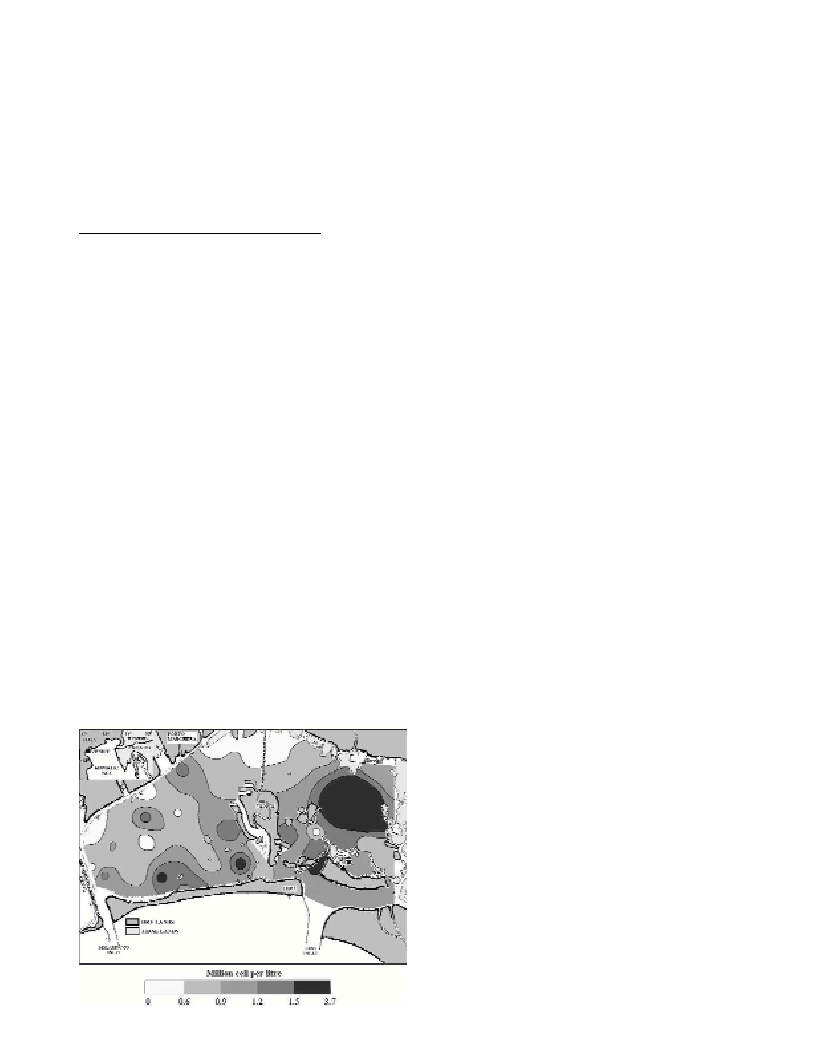SPATIAL DISTRIBUTION OF BENTHIC DIATOMS IN THE SURFACE SEDIMENT
OF VENICE LAGOON, ITALY
Facca Chiara
*
and Sfriso Adriano
Department of Environmental SciencesVenice, Italy - * facca@unive.it
Abstract
Surface sediment samples (ca. 2-3 mm) were collected in 65 stations in summer 2002, to investigate spatial distribution of the epipelic
diatoms. Total abundance varied between 0.26 and 3.60 x 10
6
cells cm
-3
. The highest values were recorded in protected areas, far from the
deepest canals. A spot distribution, with marked small-scale ?uctuations, was often observed. The community was mainly constituted by
raphid genera, such as Naviculaspp. and Nitzschiaspp., but also centric diatoms were important in some sites. Shannon diversity increased
progressively from the mainland to the sea.
Key-words: diatoms, epipelon, sediment, lagoon
Rapp. Comm. int. Mer Médit., 37,2004
518
Introduction
The ecological role of benthic diatoms, as primary producers and
sediment stabilizers, in shallow water, is widely recognized [1].
Moreover, recently, a lot of studies propose to use trophic indices
based on benthic diatom communities to assess freshwater quality (i.e.
[2]). The present study aims to describe the spatial distribution of
diatoms in the lagoon and their ability to scale trophic conditions,
also, in brackish waters.
The study area is the central part of Venice lagoon, subject to a high
water renewal and strongly affected by many anthropic activities. In
this area the mean water depth, except for the canals, does not exceed
1 m. At present macroalgal biomass is almost absent [3], but some
zones close to the port entrances are colonised by seagrasses. By
considering the whole central lagoon the dominant primary producers
are microorganisms, which live in water column or on bottom
habitats. In this paper we present the results of a spatial investigation
of benthic diatom distribution in the 2-3 mm sediment top layer of the
whole central lagoon. Epipelic diatom seasonal distribution has
already been investigated in some sites of Venice lagoon, showing
abnormal variations, often independent of temperature changes [4].
Methods
Sampling sites were located in the area comprised between the
Malamocco port entrance, in the south, and the Burano-Torcello
wetlands, in the north. Sediment samples (thick ca. 5 cm) were
collected by means of a Plexiglas corer in always-submerged zones
(1m deep), out of canals. Undisturbed surface minicores (2-3 mm
thick) were stored with hydrogen peroxide for 24 hrs and, then,
diluted with synthetic seawater [4]. Diatoms were counted and
identified by the light inverted microscope according to Utermöhl’s
method [5].
Results and Discussion
Diatom abundance, in general, was spread along an increasing
gradient from the mainland to the sea. Several spots, contrasting with
surrounding distribution, were, however, observed (Fig. 1). The
highest values (up to 3.59 x 10
6
cells cm
-3
) were recorded in protected
areas, north of Venice. The abundance was below the average value
(1.02 ±0.54 x 10
6
cells cm
-3
) along the main canals and in the areas
of intense bivalve catching, where minimum cell concentrations
occurred (0.26 x 10
6
cells cm
-3
). On the whole 84 taxa were
identified. Rhapid genera were the most abundant as both cell and
specie number, whereas arhapid diatoms were almost negligible.
Centric diatoms, in particular Thalassiosirasp., were widespread near
the mainland, south of the translagoon bridge. Amphora exigua
Gregory, Amphora veneta Kützing, Cocconeis molesta Kützing,
Navicula lanceolata Kützing, Nitzschia lanceolataSmith and
Nitzschia microcephalaGrunow were the background of benthic
community in the whole study area. Other species, such as Cocconeis
scutellumEhrenberg, varied zone by zone.
Shannon diversity index was higher along the Lido island than near
the mainland. Similarly, communities with a high number of species
were grouped near the port entrances. The diversity and the specie
number seemed to fit the trophic conditions of the lagoon better than
the abundance. In fact, nutrient concentrations are higher close to the
mainland, affected by industrial, urban and agricultural sewage in?ow
[6]. Diatom abundance was probably affected by other factors, such as
physical alterations of bottom habitats due to the frequent sediment
re-suspension/settlement phenomena. The area, where diatoms were
less abundant, was, in fact, affected by oil tanker transit and by intense
clam fishing.
References
1-MacIntyre H.L., Geider R.J., and Miller D.C., 1996.
Microphytobenthos: the ecological role of the “secret garden” of
unvegetated, shallow-water marine habitats. I. Distribution, abundance
and primary production. Estuaries, 19: 186-201.
2-Prygiel J., Whitton B.A., and Bukowska J. (eds.), 1999. Use of Algae
for Monitoring Rivers III. Agence d’Eau Artois-Picardie, Douai, France,
271 p.
3-Sfriso A., Facca C., and Ghetti P.F., 2003. Temporal and spatial
changes of macroalgae and phytoplankton in a Mediterranean coastal area:
the Venice lagoon as a case study.Mar. Environ. Res., 56: 617-636.
4-Facca C., Sfriso A., and Socal G., 2002. Temporal and spatial
distribution of diatoms in the surface sediments of the Venice lagoon. Bot.
Mar., 45: 170-183.
5-Utermöhl H., 1958. Zur Vervollkomnung der quantitativen
Phytoplankton-Methodik. Mitt. int. Verein. Limnol., 9: 1-38.
6-Sfriso A., Facca C., Ceoldo S., Silvestri S., and Ghetti P.F., 2003b. Role
of macroalgal biomass and clam fishing on spatial and temporal changes
in N and P sedimentary pools in the central part of the Venice lagoon.
Oceanol. Acta, 26: 3-13.

